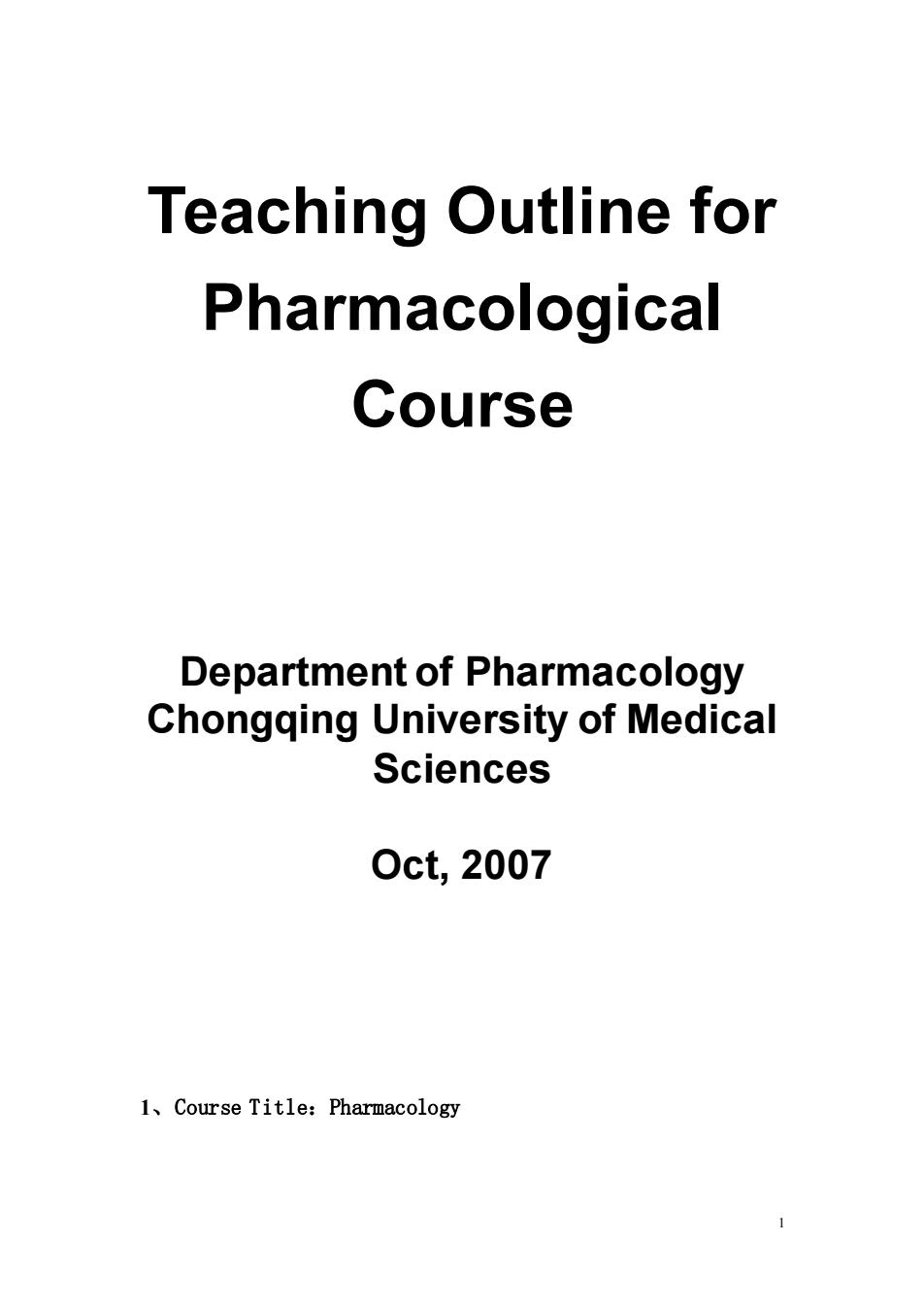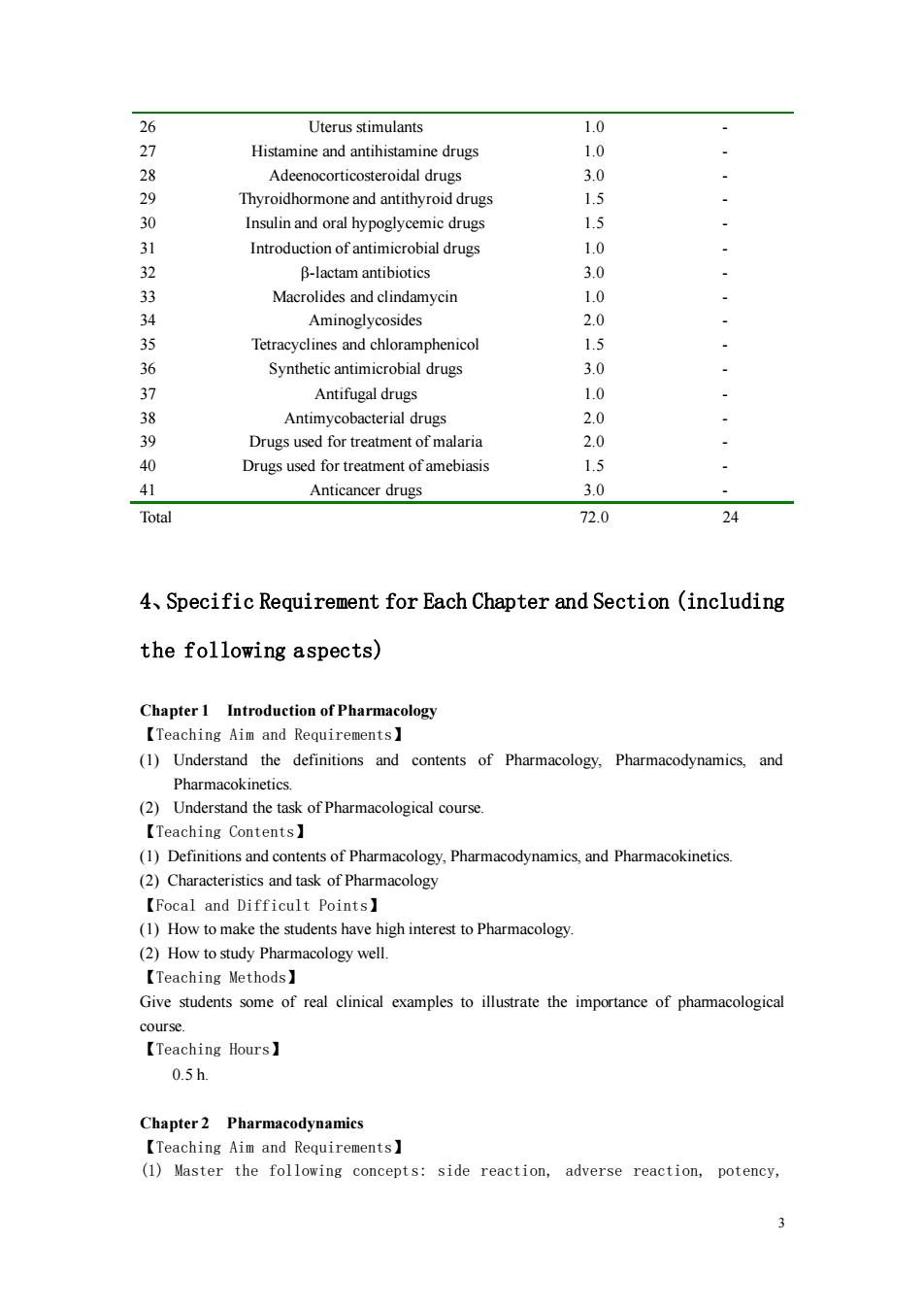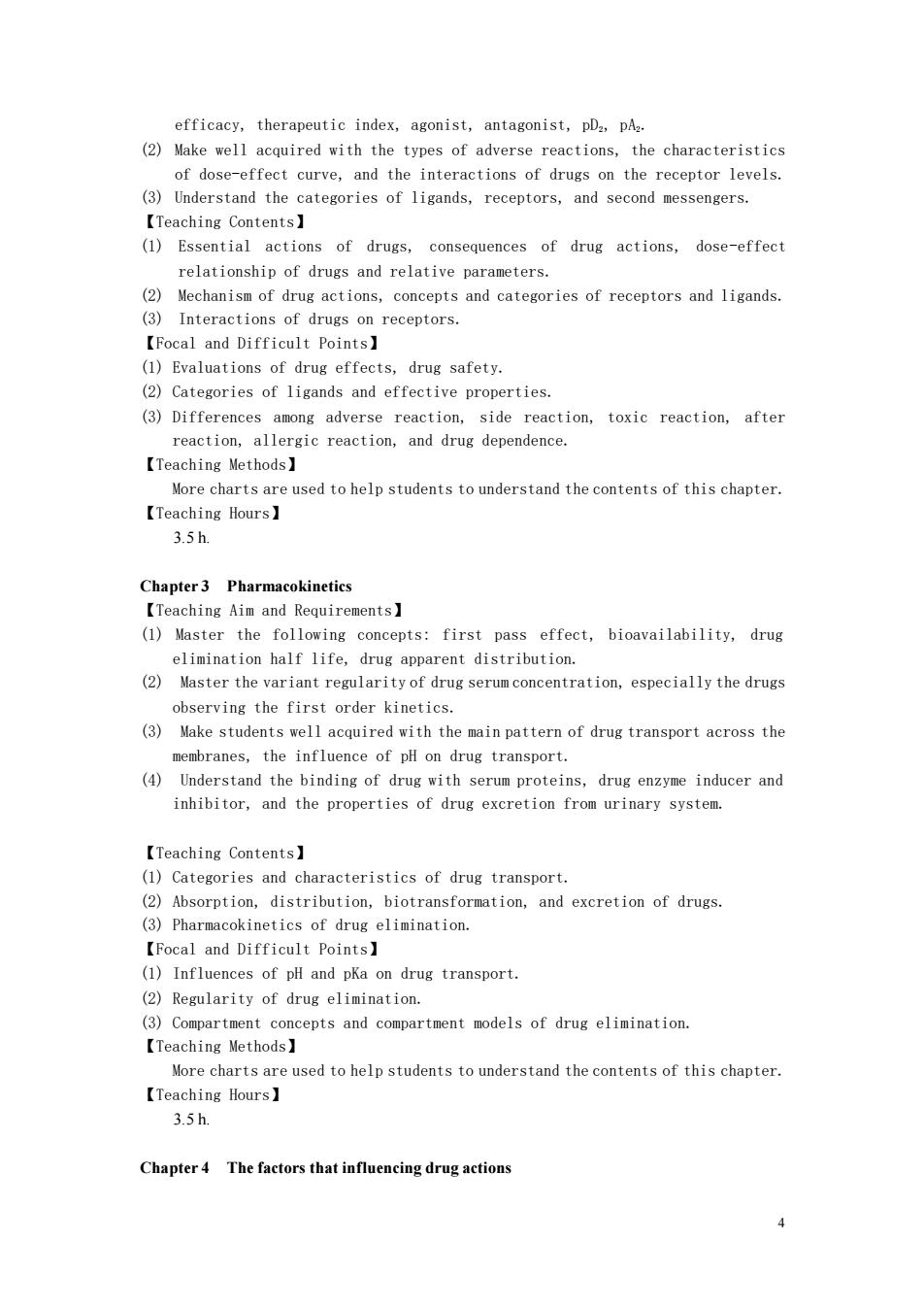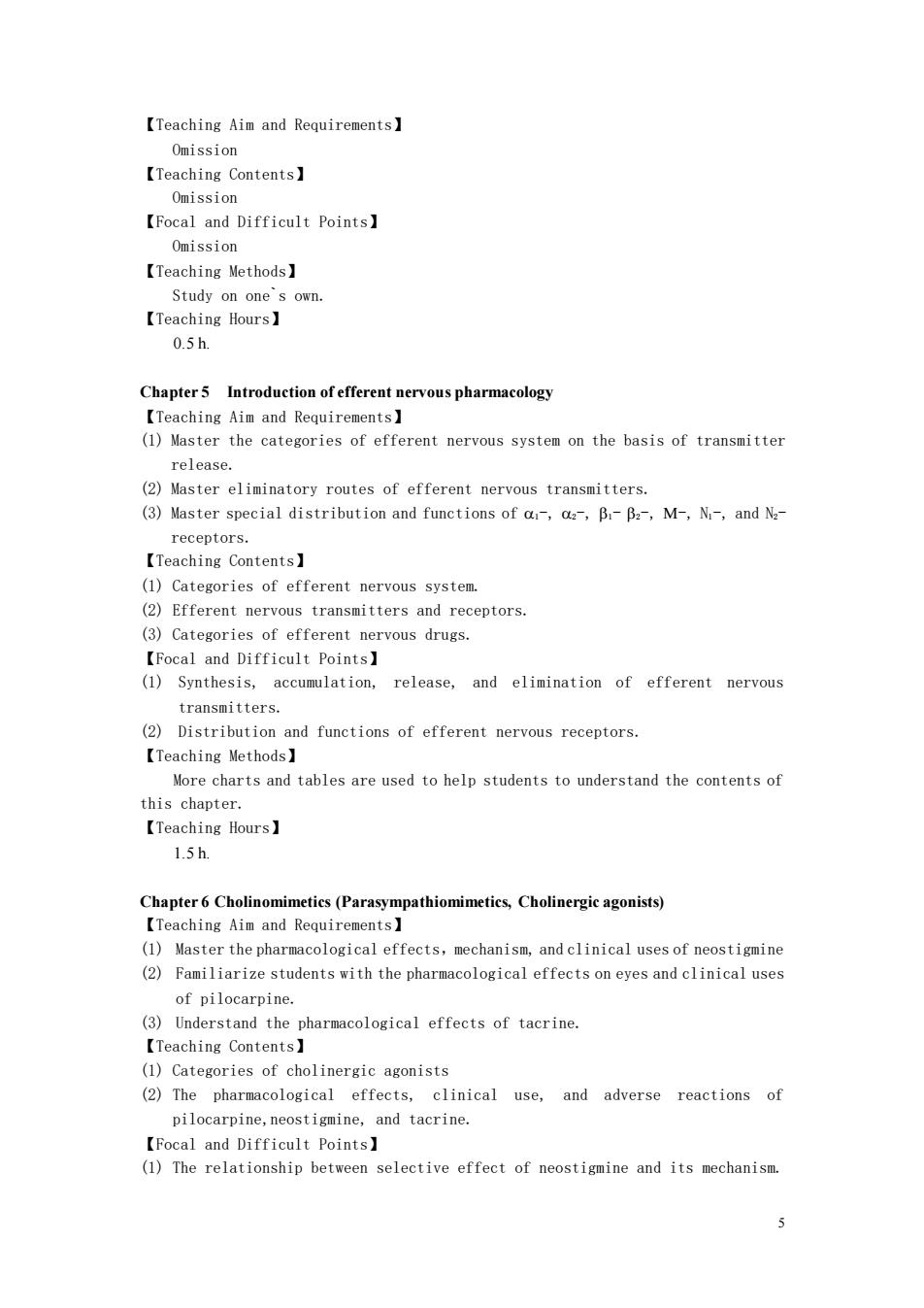
Teaching Outline for Pharmacological Course Department of Pharmacology Chongqing University of Medical Sciences 0ct,2007 1,Course Title:Pharmacology
1 Teaching Outline for Pharmacological Course Department of Pharmacology Chongqing University of Medical Sciences Oct, 2007 1、Course Title:Pharmacology

2.Course General Description Pharmacology is one of the main courses in medical education.It is a bridge connecting basic medical sciences with clinical training The aim for studying pharmacology is to help students to understand how the drugs act on the body(including the drug effects,the mechanism. the indications.the contraindications.and side effects.etc how the body deal with the drugs drug serum concentration and time ete),and how to reasonably use the drugs for treatment o diseases.All contents of pharmacology are divided into three levels according to their importance:must master the contents,should be familiar with the contents,and only understand the contents. 3,Contents of Major Chapters of the Course and Distribution of the Class Hours Chapter Content Class Teaching Lab Demostration Total Hours Hours Hours Introduction of pharmacology 0.5 Pharmacodynamics 3.5 35 4 The factors influencing drug actions 5 Introduction of efferent nervous drugs 1.0 Cholinoreceptor agonists 1.0 4 Cholinoreceptor angagonists 20 8 Adrenoceptor agonists 9 Adrenoceptor antagonists 1020 4 Sedative-hypnotic drugs 2.0 Anti-seizure drugs 1.0 Antiparkisonism drugs 345 Drugsused for treatment of psychosis 3.0 anagesics and antagonists 2.0 4 Non-steroidal antiinflammatory drugs 6 CNS stimulants 1.0 Diuretics 20 Drugs used to treat congestive heart failure 3.0 Anti 30 Drus o Antiarrhythmic drugs 20 Drugs used in hyperlipidemia 1. Anti-anemic drugs 1.0 DugsusadIotrealbloodisorders Drugs used in respiratory diseases 1.0
2 2、Course General Description Pharmacology is one of the main courses in medical education. It is a bridge connecting basic medical sciences with clinical training. The aim for studying pharmacology is to help students to understand how the drugs act on the body (including the drug effects, the mechanism, the indications, the contraindications, and side effects, etc.), how the body deal with the drugs (including drug absorption, distribution, biotransformation, excretion, and relationship between drug serum concentration and time, etc.), and how to reasonably use the drugs for treatment of diseases. All contents of pharmacology are divided into three levels according to their importance: must master the contents, should be familiar with the contents, and only understand the contents. 3、Contents of Major Chapters of the Course and Distribution of the Class Hours Chapter Content Total Hours Class Teaching Hours Lab Demostration Hours 1 2 3 4 5 6 7 8 9 10 11 12 13 14 15 16 17 18 19 20 21 22 23 24 25 Introduction of pharmacology Pharmacodynamics Pharmacokinetics The factors influencing drug actions Introduction of efferent nervous drugs Cholinoreceptor agonists Cholinoreceptor angagonists Adrenoceptor agonists Adrenoceptor antagonists Sedative-hypnotic drugs Anti-seizure drugs Antiparkisonism drugs Drugs used for treatment of psychosis Opioid anagesics and antagonists Non-steroidal antiinflammatory drugs CNS stimulants Diuretics Drugs used to treat congestive heart failure Antihypertensive drugs Drugs used to treat myocardial ischemia Antiarrhythmic drugs Drugs used in hyperlipidemia Anti-anemic drugs Drugs used to treat blood disorders Drugs used in respiratory diseases 0.5 3.5 3.5 0.5 1.0 1.0 2.0 2.0 2.0 2.0 1.0 - 3.0 2.0 2.0 1.0 2.0 3.0 3.0 1.5 2.0 1.5 1.0 1.0 1.0 - - 4 - - 4 4 4 - - - - 4 4 - - - - - - - - - - -

26 Uterus stimulants 10 27 1 Adeenocorticosteroidal drugs 30 Thyroidhormone and antithyroid drugs .5 Insulin and oral hypoglycemic drugs 15 31 Introduction of antimicrobial drugs 1.0 ctam antibiotics 30 3 Macrolides and linda amycin 0 Aminoglycosides Tetracvclines and chloramphenicol 1.5 36 Synthetic antimicrobial drugs 30 Antifugal drugs 10 Antimycobacterial drugs 20 39 Drugs used for treatment of malaria % Drugs used for treatment of amebiasis 1.5 41 Anticancer drugs 3.0 Total 72.0 24 4,Specific Requirement for Each Chapter and Section (including the following aspects) Chapter 1 Introduction of Pharmacology 【Teaching Aim and Requirements】 (1)Understand the definitions and contents of Pharmacology.Pharmacodynamics,and netics (2)Understand the task of Pharmacological course 【Teaching Contents】 (1)Definitions and contents of Pharmacology,Pharmacodynamics,and Pharmacokinetics. ()Characteristics and task of Pharmacology 【Focal and Difficult Points】 (1)How to make the students have high interest to Pharmacology (2)How to study Pharmacology well. 【Teaching Methods】 Give students some of real clinical examples to illustrate the importance of phammacological course 【Teaching Hours】 0.5h Chapter2 Pharmacodynamics 【Teaching Aim and Requirements】 (1)Master the follo ing concepts:side reaction, adverse reaction, potency
3 26 27 28 29 30 31 32 33 34 35 36 37 38 39 40 41 Uterus stimulants Histamine and antihistamine drugs Adeenocorticosteroidal drugs Thyroidhormone and antithyroid drugs Insulin and oral hypoglycemic drugs Introduction of antimicrobial drugs -lactam antibiotics Macrolides and clindamycin Aminoglycosides Tetracyclines and chloramphenicol Synthetic antimicrobial drugs Antifugal drugs Antimycobacterial drugs Drugs used for treatment of malaria Drugs used for treatment of amebiasis Anticancer drugs 1.0 1.0 3.0 1.5 1.5 1.0 3.0 1.0 2.0 1.5 3.0 1.0 2.0 2.0 1.5 3.0 - - - - - - - - - - - - - - - - Total 72.0 24 4、Specific Requirement for Each Chapter and Section (including the following aspects) Chapter 1 Introduction of Pharmacology 【Teaching Aim and Requirements】 (1) Understand the definitions and contents of Pharmacology, Pharmacodynamics, and Pharmacokinetics. (2) Understand the task of Pharmacological course. 【Teaching Contents】 (1) Definitions and contents of Pharmacology, Pharmacodynamics, and Pharmacokinetics. (2) Characteristics and task of Pharmacology 【Focal and Difficult Points】 (1) How to make the students have high interest to Pharmacology. (2) How to study Pharmacology well. 【Teaching Methods】 Give students some of real clinical examples to illustrate the importance of pharmacological course. 【Teaching Hours】 0.5 h. Chapter 2 Pharmacodynamics 【Teaching Aim and Requirements】 (1) Master the following concepts: side reaction, adverse reaction, potency

efficacy.therapeutic index.agonist.antagonist.pD.DA. (2)Make well acquired with the types of adverse reactions,the characteristics of dose-effect curve,and the interactions of drugs on the receptor levels. (3)Understand the categories of ligands,receptors,and second messengers. 【Teaching Contents】 (1)Essential actions of drugs.consequences of drug actions.dose-effect relationship of drugs and relative parameters (2)Mechanism of drug actions,concepts and categories of receptors and ligands. (3)Interactions of drugs on receptors. 【Focal and Difficult Points】 (1)Evaluations of drug effects,drug safety. (2)Categories of ligands and effective properties. (3)Differences among adverse reaction,side reaction,toxic reaction,after reaction,allergic reaction,and drug dependence. 【Teaching Methods】 More charts are used to help students to understand the contents of this chapter. 【Teaching Hours】 35h Chapter3 Pharmacokinetics 【Teaching Aim and Requirements】 (1)Master the following concepts:first pass effect,bioavailability,drug ent distribution. observing the first order kinetics (3)Make students well acquired with the main pattern of drug transport across the membranes,the influence of pH on drug transport. (4)Inderstand the binding of drug with serum proteins,drug e inducer and inhibitor, and the e properties of drug excre from urinary systen 【Teaching Contents】 (1)Categories and characteristics of drug transport. (2)Absorption,distribution,biotransformation,and excretion of drugs. ng elimination 【Focal and Difficult Points】 (1)Influences of pH and pKa on drug transport. (2)Regularity of drug elimination. (3)Compartment concepts and compartment models of drug elimination. 【Teaching Methods】 e charts a e used to help students to understand the contents of this chapter 【Teaching Hours】 3.5h Chapter4 The factors that influencing drug actions
4 efficacy, therapeutic index, agonist, antagonist, pD2, pA2. (2) Make well acquired with the types of adverse reactions, the characteristics of dose-effect curve, and the interactions of drugs on the receptor levels. (3) Understand the categories of ligands, receptors, and second messengers. 【Teaching Contents】 (1) Essential actions of drugs, consequences of drug actions, dose-effect relationship of drugs and relative parameters. (2) Mechanism of drug actions, concepts and categories of receptors and ligands. (3) Interactions of drugs on receptors. 【Focal and Difficult Points】 (1) Evaluations of drug effects, drug safety. (2) Categories of ligands and effective properties. (3) Differences among adverse reaction, side reaction, toxic reaction, after reaction, allergic reaction, and drug dependence. 【Teaching Methods】 More charts are used to help students to understand the contents of this chapter. 【Teaching Hours】 3.5 h. Chapter 3 Pharmacokinetics 【Teaching Aim and Requirements】 (1) Master the following concepts: first pass effect, bioavailability, drug elimination half life, drug apparent distribution. (2) Master the variant regularity of drug serum concentration, especially the drugs observing the first order kinetics. (3) Make students well acquired with the main pattern of drug transport across the membranes, the influence of pH on drug transport. (4) Understand the binding of drug with serum proteins, drug enzyme inducer and inhibitor, and the properties of drug excretion from urinary system. 【Teaching Contents】 (1) Categories and characteristics of drug transport. (2) Absorption, distribution, biotransformation, and excretion of drugs. (3) Pharmacokinetics of drug elimination. 【Focal and Difficult Points】 (1) Influences of pH and pKa on drug transport. (2) Regularity of drug elimination. (3) Compartment concepts and compartment models of drug elimination. 【Teaching Methods】 More charts are used to help students to understand the contents of this chapter. 【Teaching Hours】 3.5 h. Chapter 4 The factors that influencing drug actions

【Teaching Aim and Requirements】 Omission 【Teaching Contents】 Omission 【Focal and Difficult Points】 Omission 【Teaching Methods】 Study one 【Teaching Hours】 0.5h Chapter5 Introduction of efferent nervous pharmacology 【Teaching Ai and Requirements】 (1)Master the categories of efferent nervous system on the basis of transmitter release (2)Master eliminatory routes of efferent nervous transmitters. (3)Master special distribution and functions of a-,a-,B-B:-,M-,N-,and N- receptors 【Teaching Contents】 (1)Categories of efferent nervous system. (2)Efferent nervous transmitters and receptors. (3)Categories of efferent nervous drugs. 【Focal and Difficult Points】 ()Synthesis, accumulation, release,and elimination of efferent nervous transmitters (2)Distribution and functions of efferent nervous receptors. 【Teaching Methods】 More charts and tables are used to help students to understand the contents of this chanter 【Teaching Hours】 1.5h. Chapter6 Cholinomimetics(Parasympathiomimetics,Cholinergic agonists) 【Teaching Aim and Requirements】 (1)Master the pharmacological effects,mechanism,and clinical uses of neostigmine (2)Familiarize students with the pharmacological effects on eyes and clinical uses of pilocarpine. (3)Understand the pharmacological effects of tacrine. 【Teaching Contents】 (1)Categories of cholinergic agonists (2)The pharmacological effects,clinical use,and adverse reactions of pilocarpine,neostigmine,and tacrine. 【Focal and Difficult Points】. (1)The relationship between selective effect of neostigmine and its mechanism. 5
5 【Teaching Aim and Requirements】 Omission 【Teaching Contents】 Omission 【Focal and Difficult Points】 Omission 【Teaching Methods】 Study on one`s own. 【Teaching Hours】 0.5 h. Chapter 5 Introduction of efferent nervous pharmacology 【Teaching Aim and Requirements】 (1) Master the categories of efferent nervous system on the basis of transmitter release. (2) Master eliminatory routes of efferent nervous transmitters. (3) Master special distribution and functions of 1-, 2-, 1- 2-, -, N1-, and N2- receptors. 【Teaching Contents】 (1) Categories of efferent nervous system. (2) Efferent nervous transmitters and receptors. (3) Categories of efferent nervous drugs. 【Focal and Difficult Points】 (1) Synthesis, accumulation, release, and elimination of efferent nervous transmitters. (2) Distribution and functions of efferent nervous receptors. 【Teaching Methods】 More charts and tables are used to help students to understand the contents of this chapter. 【Teaching Hours】 1.5 h. Chapter 6 Cholinomimetics (Parasympathiomimetics, Cholinergic agonists) 【Teaching Aim and Requirements】 (1) Master the pharmacological effects,mechanism, and clinical uses of neostigmine (2) Familiarize students with the pharmacological effects on eyes and clinical uses of pilocarpine. (3) Understand the pharmacological effects of tacrine. 【Teaching Contents】 (1) Categories of cholinergic agonists (2) The pharmacological effects, clinical use, and adverse reactions of pilocarpine,neostigmine, and tacrine. 【Focal and Difficult Points】 (1) The relationship between selective effect of neostigmine and its mechanism